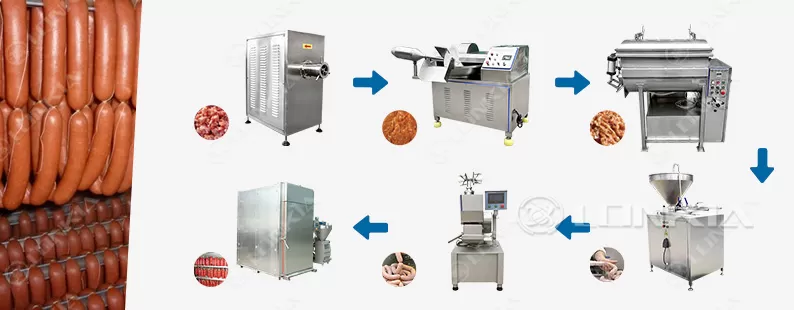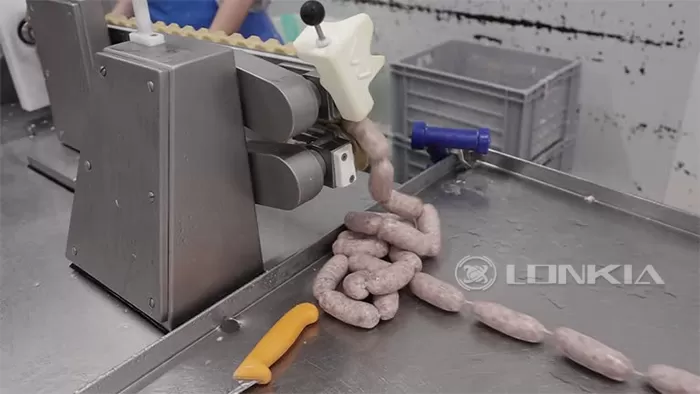Sausage production is a highly technical process that requires precision, consistency, and hygiene to ensure a high-quality final product. From ingredient preparation to stuffing, cooking, and packaging, manufacturers face several challenges that can affect efficiency, product quality, and compliance with food safety regulations.
In this article, we’ll discuss some of the most common challenges in sausage production and how to overcome them for a smoother and more efficient operation.

1. Maintaining Consistent Texture and Flavor
🔍 The Challenge:
Inconsistent texture and flavor can lead to variations in product quality, affecting consumer satisfaction and brand reputation. Factors such as grinding, mixing, and seasoning distribution can impact the final taste and mouthfeel of the sausage.
✅ How to Overcome It:
Use high-quality meat with the right fat-to-lean ratio.
Ensure uniform grinding to achieve the desired texture.
Invest in automated mixing systems to evenly distribute seasonings and ingredients.
Standardize recipes and processing parameters to maintain consistency.
2. Efficient and Precise Stuffing
🔍 The Challenge:
Improper stuffing can cause air pockets, casing breakage, or uneven sausage sizes, affecting both appearance and cooking performance.
✅ How to Overcome It:
Use vacuum filling machines to remove air pockets and ensure consistent stuffing.
Regularly check and adjust casing tension to prevent breakage.
Optimize filling speed and pressure to maintain uniformity.
Choose the right casing type (natural, collagen, or synthetic) based on product requirements.
3. Achieving Proper Cooking and Smoking
🔍 The Challenge:
Uneven cooking or smoking can lead to incomplete sterilization, flavor imbalance, and texture issues. Overcooking can also result in dry and tough sausages, while undercooking poses food safety risks.
✅ How to Overcome It:
Utilize temperature-controlled smoking and cooking chambers to ensure even heat distribution.
Monitor internal temperatures with real-time sensors to prevent undercooking or overcooking.
Use automated steam and smoke injection systems for precision and consistency.
Follow a standardized cooking and smoking process to achieve repeatable results.

4. Maintaining Hygiene and Food Safety Compliance
🔍 The Challenge:
Sausage production facilities must adhere to strict hygiene and food safety regulations, such as HACCP, GMP, and FDA standards. Contamination can result in product recalls, legal issues, and loss of consumer trust.
✅ How to Overcome It:
Implement regular cleaning and sanitation protocols for all equipment and surfaces.
Use stainless steel machinery to prevent bacterial buildup.
Conduct routine microbial testing to ensure food safety.
Train workers on proper handling procedures to minimize contamination risks.
5. Packaging and Shelf-Life Extension
🔍 The Challenge:
Improper packaging can lead to moisture loss, oxidation, and bacterial growth, reducing shelf life and affecting product quality.
✅ How to Overcome It:
Use vacuum or modified atmosphere packaging (MAP) to extend shelf life.
Ensure airtight sealing to prevent oxygen exposure.
Store sausages at optimal temperatures to maintain freshness.
Test packaging materials for durability and food safety compliance.
Conclusion
Sausage production requires precise control at every stage to maintain quality, efficiency, and food safety. By addressing common challenges such as texture consistency, stuffing accuracy, cooking precision, hygiene, and packaging, manufacturers can improve productivity and deliver high-quality sausages to the market.
At LONKIA Machinery, we offer advanced sausage processing equipment, including mixers, grinders, stuffers, cooking chambers, and packaging solutions, to help food manufacturers optimize their production lines. Contact us today to find the right solution for your business!
